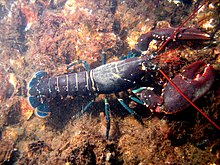Homarus
|
Homarus Temporal range: Albian–Recent |
|
|---|---|
 |
|
| Homarus gammarus | |
| Scientific classification | |
| Kingdom: | Animalia |
| Phylum: | Arthropoda |
| Subphylum: | Crustacea |
| Class: | Malacostraca |
| Order: | Decapoda |
| Family: | Nephropidae |
| Genus: |
Homarus Weber, 1795 |
| Type species | |
|
Astacus marinus Fabricius, 1775 |
|
| Extant species | |
|
H. americanus – American lobster |
|
H. americanus – American lobster
H. gammarus – European lobster
Homarus is a genus of lobsters, which include the common and commercially significant species Homarus americanus (the American lobster) and Homarus gammarus (the European lobster). The Cape lobster, which was formerly in this genus as H. capensis, was moved in 1995 to the new genus Homarinus.
Homarus is one of three extant genera of clawed lobsters to show dimorphism between claws – a specialisation into a crushing claw and a cutting claw. The other similar genera are Nephrops, which is much more slender, and has grooves along the claws and the abdomen, and Homarinus, the Cape lobster from South Africa, which is even smaller, and has hairy claws.
While analyses of morphology suggest a close relationship between Homarinus and Homarus, molecular analyses using reveal that they are not sister taxa. Both genera lack ornamentation such as spines and , but are thought to have reached that state independently, through convergent evolution. The closest living relative of Homarus is Nephrops norvegicus, while the closest relatives of Homarinus are Thymops and Thymopides.
Eight extinct species are known from the fossil record, which stretches back to the Cretaceous, but only two species survive. These two species, the American lobster and the European lobster, are very similar and may have speciated as recently as the , during climatic fluctuations. The best characters for distinguishing them are the geographic distribution, with the American lobster in the western Atlantic and the European lobster in the eastern Atlantic, and by the presence of one or more teeth on the underside of the rostrum in H. americanus but not in H. gammarus.
...
Wikipedia
